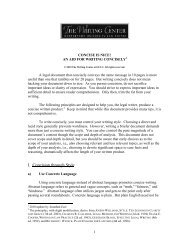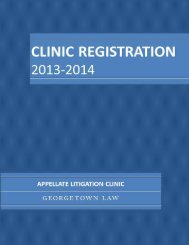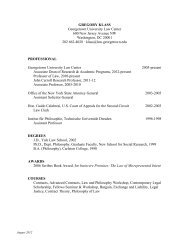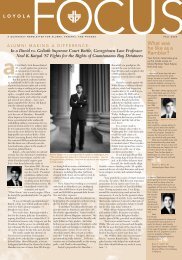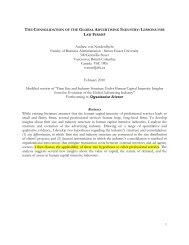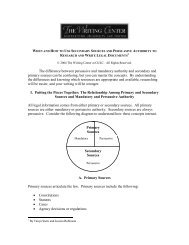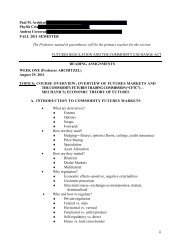Date: April 12, 2013 Topic: The Shrinking ... - Georgetown Law
Date: April 12, 2013 Topic: The Shrinking ... - Georgetown Law
Date: April 12, 2013 Topic: The Shrinking ... - Georgetown Law
You also want an ePaper? Increase the reach of your titles
YUMPU automatically turns print PDFs into web optimized ePapers that Google loves.
connection with the knowledge provider. <strong>The</strong>refore, KMS reduces the need for forming new ties<br />
to gain new knowledge. From this perspective, one would expect that a manager’s technology<br />
use to access a partner’s knowledge (by downloading the partner ’s documents in the KMS) will<br />
decrease the likelihood of new tie formation between the manager and the partner.<br />
Yet our qualitative interviews suggest that technology use without relationships could be<br />
dangerous. People who perceive the risks of misusing distant knowledge might like to connect<br />
with distant partners in order to clarify the appropriate use of that knowledge, but they have no<br />
immediate access to forming those relationships. One possible solution would be to rely on<br />
indirect contacts in order to form relationships with distant knowledge providers. This use of preexisting<br />
social capital in order to form a new relationship with a knowledge provider is<br />
consistent with the social perspective that highlights the importance of interpersonal<br />
relationships in shaping technology use.<br />
Integrating the materialist and social perspectives suggests that the benefits of knowledge<br />
acquired from technology use can be perceived and acted on when surrounded by a context of<br />
complementary social capital. This social capital context should make it more feasible to<br />
conceive of the potential fruitfulness of collaborating. For example, one of our interviewers<br />
(documented above) commented that after downloading a partner’s documents, he was more<br />
likely to connect with that partner if already somewhat acquainted, but not if he lacked any<br />
connection. <strong>The</strong>refore, we expect that technology use combined with indirect ties from a<br />
manager to a partner will increase the likelihood of new tie formation, while technology use<br />
lacking pre-existing social capital will not.<br />
H1: Managers downloading documents of partners with whom they have prior indirect<br />
ties (social capital) will increase the likelihood of new tie formation, relative to<br />
downloading documents of partners without prior ties (no social capital).<br />
Technology use and value creation<br />
Research on innovation and value creation suggests that the discovery and combination<br />
of knowledge from different domains helps to foster new knowledge creation (Leonard-Barton<br />
1995; Burt 2004). Hence our baseline expectation about the influence of technology use on value<br />
creation in the law firm is positive. <strong>The</strong> vision for KMS use, largely rooted in a materialist<br />
perspective, holds that these systems should facilitate effective search and use of existing<br />
knowledge to surface new solutions for clients. Those new solutions might include the<br />
development of new types of services, or the adaptation of existing services to match the needs<br />
of new clients.<br />
For example, a lawyer whose client is considering opening a manufacturing plant in<br />
another country may want to consider a range of issues including tax, intellectual property, and<br />
labour law. If that lawyer turns to her firm’s KMS to search for relevant documents, she may<br />
find examples that are similar but not spot-on. Hence the knowledge content of prior documents<br />
cannot simply be replicated, but hopefully by combining those prior documents, she can produce<br />
higher quality advice for her client. Without the ability to access and integrate prior knowledge<br />
through the KMS, the partner would never have been able to provide that increased level of<br />
service. Further, in subsequent years, that partner may be able to integrate insights gained from<br />
those diverse document inputs for other value creating opportunities, such as analyzing the legal<br />
merits and risks of plant relocations for other clients—leading to additional increases in client<br />
work and revenues.<br />
<br />
5



